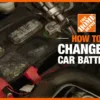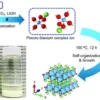Are you wondering do lithium golf cart batteries need water? Choosing the right battery for your golf cart can make or break your experience on the course or around the neighborhood.
As a golf cart enthusiast, I’ve seen firsthand how battery maintenance impacts performance and longevity. In this guide, I’ll share practical insights based on real-world expertise to answer your question and help you decide if lithium golf cart batteries are the right fit for you.
We’ll explore why lithium batteries are different, their maintenance needs, and how they stack up against traditional lead-acid options.
Let’s get rolling!
What Are Lithium Golf Cart Batteries
Lithium golf cart batteries are advanced rechargeable batteries that use lithium-ion technology to power golf carts. Unlike traditional lead-acid batteries, lithium batteries store energy more efficiently and offer a longer lifespan. These batteries are designed specifically to provide steady, reliable power for golf carts, allowing for longer rides without frequent recharging.
Lithium batteries are lightweight and compact, which helps improve the overall performance and handling of golf carts. They are sealed units, meaning they don’t require maintenance like topping off with water, which is common with some older battery types. This makes lithium golf cart batteries a popular choice for golf cart owners looking for convenience, durability, and better energy efficiency.
How Lithium Batteries Work

Lithium golf cart batteries store energy using lithium ions that move between the battery’s positive and negative electrodes during charging and discharging. When you charge the battery, lithium ions move from one side to the other, storing energy. When you use the golf cart, the ions move back, releasing energy to power the motor.
Unlike lead acid batteries, lithium batteries don’t rely on heavy chemicals or liquid electrolytes, which means they can deliver power more efficiently and last longer. This setup also helps keep the battery lighter and reduces the chances of leaks or corrosion.
Since lithium batteries don’t have liquid that can evaporate or spill, their design is more sealed and solid. This is why they require less maintenance compared to traditional lead acid batteries commonly used in golf carts.
In short, the way lithium batteries work allows for better performance, longer lifespan, and easier upkeep, which is why they’re becoming the preferred choice for golf cart users across the U.S.
Longer Life and Run Time

One of the biggest benefits of lithium golf cart batteries is their longer life and run time compared to traditional lead acid batteries. Lithium batteries hold a charge much better, so you get more consistent power during your rounds. This means fewer pit stops to recharge or swap out batteries on the course.
You can expect lithium batteries to last several times longer in terms of total charge cycles. That translates to years of reliable use, reducing the hassle and cost of frequent replacements. Plus, their efficient energy use means your golf cart can run longer on a single charge — perfect for those extended days on the links.
In short, choosing lithium means more time playing and less time worrying about your battery running out.
Benefits of Lithium Golf Cart Batteries
Lighter Weight for Better Performance
One of the biggest perks of lithium golf cart batteries is how much lighter they are compared to traditional lead-acid batteries. This lighter weight makes a noticeable difference in your golf cart’s overall performance. When your cart is carrying less weight, it runs more smoothly and uses less energy to get around the course. That means quicker acceleration, better handling, and improved efficiency.
Because lithium batteries are compact and weigh about half as much as lead-acid batteries, they also put less strain on your golf cart’s motor. This can help extend the life of your cart’s mechanical parts. Plus, the lighter setup is easier to install and remove if you ever need to perform maintenance or upgrades.
For those who value speed and nimbleness on the course, lithium batteries offer a clear advantage thanks to their lightweight design. It’s a win-win: better play for you and less wear and tear on your golf cart.
Benefits of Lithium Golf Cart Batteries Lower Maintenance Needs
One of the biggest perks of lithium golf cart batteries is how low-maintenance they are. Unlike traditional lead acid batteries, lithium batteries don’t require you to check or add water regularly. You won’t need to worry about acid spills or corrosion around terminals, which means less time cleaning and more time on the course.
Here’s why lithium batteries stand out for maintenance:
- No Watering Needed: These batteries are sealed and maintenance-free, so you never have to top off water.
- No Equalizing Charges: Lead acid batteries sometimes need special charges to balance cells; lithium batteries don’t.
- Longer Lifespan: Because they hold a charge better and discharge evenly, lithium batteries last longer, saving you replacement hassles.
- Consistent Performance: They maintain steady power output without the sudden drops common in lead acid batteries.
For anyone tired of the constant upkeep with traditional batteries, lithium offers a hassle-free, cleaner, and safer experience. This makes them perfect for users who want to keep their golf cart in top shape with minimal effort.
Cost Differences
When comparing lithium golf cart batteries to traditional lead-acid batteries, cost is a big factor for most buyers. Lithium batteries tend to come with a higher upfront price—sometimes two to three times more than lead-acid options. This can make them seem pricey at first.
However, the higher initial cost often balances out over time because lithium batteries last longer and need less maintenance. Lead-acid batteries usually require regular watering, equalizing charges, and replacement every 3 to 5 years. Lithium batteries, on the other hand, often offer 8 to 10 years of use with minimal upkeep.
For U.S. customers looking at the price tag, think of lithium batteries as an investment. You pay more at the start but save money on replacements, maintenance, and even charging costs down the road. Plus, their lighter weight helps reduce wear and tear on your golf cart, potentially cutting repair costs.
In short, while lead acid vs lithium golf cart battery cost looks better upfront for lead acid, lithium batteries usually prove more cost-effective in the long run thanks to their lifespan and efficiency.
Performance and Efficiency

When it comes to performance and efficiency, lithium golf cart batteries clearly stand out compared to lead-acid batteries. Lithium batteries deliver more consistent power throughout their charge cycle, so your golf cart runs stronger and longer before needing a recharge. Lead-acid batteries often lose power gradually, meaning your cart slows down as the battery drains.
Lithium batteries also charge faster and handle deeper discharges without damage, giving you more usable run time. This means less downtime on the course and fewer battery replacements in the long run. On the other hand, lead-acid batteries require regular charging and don’t respond well to deep discharges, which shortens their lifespan.
You’ll notice lithium batteries stay cooler while working, which improves efficiency and cuts down energy waste. This also reduces the chance of overheating—a common problem with older lead-acid tech.
In simple terms:
- Lithium batteries provide steady, reliable power
- They recharge quicker and last longer between charges
- Run cooler for better energy use and safety
- Lead-acid batteries lose power faster and need more frequent charging
For anyone looking for a golf cart battery that maximizes performance with less hassle, lithium batteries offer a clear advantage. They might cost more upfront, but the efficiency gains and longer lifespan often make them a smarter choice for regular golf cart use.
Environmental Impact of Lithium and Lead-Acid Batteries
When it comes to the environment, lithium golf cart batteries have a clear edge over lead-acid batteries. Lead-acid batteries contain toxic materials like lead and acid that can be harmful if spilled or not disposed of properly. They also need more frequent replacement, which means more waste over time.
On the other hand, lithium batteries last much longer, which cuts down on how often you need to replace them. They’re also lighter, so transporting and manufacturing them uses less energy overall. Plus, lithium batteries don’t have the same harmful chemicals, making recycling safer and less costly.
Here’s a quick look at the environmental differences:
- Lead-acid batteries: More toxic chemicals, frequent replacement, heavier weight increases shipping emissions, tougher recycling process
- Lithium batteries: Fewer toxic materials, longer lifespan reduces waste, lighter weight lowers transportation impact, easier and safer to recycle
For anyone looking to reduce their carbon footprint and environmental impact with their golf cart, switching to lithium is a smart move. It’s about cleaner energy, less waste, and safer recycling for your local environment.
Maintenance Requirements for Lithium Batteries
Do Lithium Batteries Need Water
No, lithium golf cart batteries do not need water. Unlike traditional lead acid batteries, lithium batteries are sealed and maintenance-free, which means you never have to add water or check electrolyte levels. This makes them a lot easier to own and maintain here in the U.S. Whether you live in a dry climate or a humid area, you won’t have to worry about topping off water to keep your battery working.
This low maintenance is one of the big benefits of lithium batteries compared to lead acid. It cuts down on regular upkeep and helps avoid common issues like corrosion or acid spills. So, if you’re looking for a hassle-free golf cart battery with longer life and less upkeep, lithium is the way to go.
Key points about lithium battery maintenance:
- No watering needed at all
- Fully sealed design prevents leaks
- Lower risk of corrosion or acid damage
- Saves time and effort on upkeep
For those used to maintaining lead acid golf cart batteries, this alone makes switching to lithium a smart choice.
Charging Best Practices for Lithium Golf Cart Batteries
Charging your lithium golf cart battery the right way is key to getting the most out of it. Unlike lead acid batteries, lithium batteries need less frequent charging but should be charged correctly to maintain their lifespan and performance.
Here are some simple charging best practices:
- Use a charger designed for lithium batteries – This ensures the voltage and current are set properly to avoid damage.
- Avoid deep discharges – Try not to run your battery completely down before charging; topping up regularly keeps it healthy.
- Charge in a cool, dry place – Heat can reduce battery life, so avoid charging in extreme temperatures.
- Don’t overcharge – Most lithium chargers have built-in protections, but it’s best not to leave batteries charging unattended for long periods.
- Follow manufacturer guidelines – Each lithium golf cart battery may have specific charging recommendations. Sticking to these prevents issues and keeps your battery going strong.
By sticking to these tips, you’ll enjoy longer battery life, better performance, and fewer maintenance headaches compared to older lead acid golf cart batteries.
Proper Handling of Lithium Batteries
When dealing with lithium golf cart batteries, safety is a top priority. These batteries pack a lot of power in a small package, so handling them the right way helps prevent accidents and keeps your golf cart running smoothly.
Here’s what you need to keep in mind:
-
Avoid Physical Damage
Don’t drop, puncture, or crush lithium batteries. Any damage can cause internal shorts, which might lead to overheating or fire.
-
Use the Correct Charger
Always charge your lithium golf cart battery with a charger made for lithium batteries. Using the wrong charger can cause overcharging or undercharging, reducing battery life and increasing fire risk.
-
Store Properly
Keep batteries in a cool, dry place away from direct sunlight or extreme temperatures. Heat speeds up wear and can cause swelling or leaks.
-
Handle With Dry Hands
Make sure your hands are dry before handling batteries to avoid accidental electric shocks and corrosion.
-
Inspect Regularly
Check for swelling, cracks, or corrosion on terminals. If you notice anything unusual, stop using the battery and get it checked by a professional.
-
Disconnect When Not in Use
If your golf cart won’t be used for a while, disconnect the battery. This lowers the chance of accidental short circuits.
Following these simple steps can prevent many common battery problems and keep your lithium golf cart battery safer for everyday use. Always remember that proper care extends the battery’s life and keeps your golf cart performing at its best.
Preventing Overheating and Fires
With lithium golf cart batteries, safety is a top priority, especially when it comes to avoiding overheating and fires. Here’s what you need to know to keep things running safely:
- Avoid Overcharging: Always use a charger designed for lithium batteries. Overcharging can cause the battery to heat up and increase the risk of fire.
- Charge in a Well-Ventilated Area: Charging your battery in a place with plenty of airflow helps keep temperatures down.
- Do Not Expose to Extreme Heat: Leaving your golf cart or batteries in direct sunlight or hot environments can lead to overheating.
- Inspect Regularly for Damage: Check your battery and connections for any signs of swelling, corrosion, or damage. Faulty parts can cause short circuits and fires.
- Use Battery Management Systems (BMS): Most quality lithium batteries come with built-in BMS that monitor temperature and voltage to prevent overheating.
- Avoid Physical Impact: Dropping or banging your lithium battery can damage internal cells, increasing fire risk.
- Store Properly: When not in use, keep your batteries in a cool, dry place away from flammable materials.
By following these simple steps, you’ll reduce the risk of battery fires and keep your golf cart running safely and efficiently.
Choosing the Right Lithium Battery for Your Golf Cart Key Factors to Consider
Picking the right lithium golf cart battery matters a lot for performance and value. Here are the main things to keep in mind:
Capacity and Voltage
Make sure the battery matches your golf cart’s voltage (usually 36V or 48V). Capacity, measured in amp-hours (Ah), affects how long your cart will run before needing a recharge. Higher Ah means longer run time.
Battery Size and Weight
Lithium batteries are lighter than lead acid, but you still want one that fits well in your cart’s battery compartment. The right size makes installation easier and maintains good balance for better handling.
Battery Life and Warranty
Look for batteries with a long service life and solid warranty coverage. A typical lithium golf cart battery can last 5 to 10 years, depending on usage and care.
Brand Reputation and Support
Choose a trusted brand that offers good customer support and reliable performance. Brands known in the U.S. market often provide better quality and after-sale service.
Cost vs Value
Lithium batteries cost more upfront compared to lead acid, but you save money over time with longer life, less maintenance, and improved efficiency.
Compatibility and Upgrade Options
Check that the battery is compatible with your cart’s charger and electrical system. Some models make future upgrades easier with modular designs.
By keeping these factors in mind, you can pick a lithium golf cart battery that fits your needs and gives you reliable performance on the course.
Popular Brands and Models of Lithium Golf Cart Batteries

When it comes to choosing the right lithium golf cart battery, picking a reliable brand makes a big difference. Here are some popular brands that are trusted by golf cart owners across the U.S.:
1. Li-ess
Known for combining quality with performance, Li-ess batteries offer long life and consistent power. Their focus on durability and safety makes them a solid choice for those who want dependable lithium batteries.
2. RoyPow
RoyPow is a well-known name offering affordable lithium batteries with decent lifespan and good customer support. They are great if you want to upgrade from lead acid without breaking the bank.
3. Dakota Lithium
Dakota Lithium batteries come with strong warranties and excellent cycle life. They specialize in rugged, long-lasting batteries suited for all kinds of golf carts.
4. Trojan Lithium
Trojan is a trusted brand in golf battery circles and their lithium line keeps that reputation. They deliver high performance and efficiency in a lightweight package.
When choosing a model, consider:
- Battery capacity (usually 12V or 48V systems for golf carts)
- Cycle life and warranty length
- Weight and size to ensure it fits your cart
- Customer support and availability of replacements
Picking the right lithium battery from a trusted brand ensures better performance, less maintenance, and longer life for your golf cart.
Maximizing the Life of Your Lithium Battery Storage Tips
Storing your lithium golf cart batteries right can make a big difference in how long they last. Here are a few easy tips to keep your battery healthy when you’re not using your golf cart regularly:
- Keep it charged between 50% and 80%: Lithium batteries don’t like sitting fully drained or fully charged for long periods. Aim to store them at about half to three-quarters charge.
- Store in a cool, dry place: Extreme heat or cold can damage the battery cells. Room temperature, away from direct sunlight, is best.
- Avoid long-term storage with a dead battery: If stored completely discharged, the battery can lose capacity or become unusable.
- Check the battery every couple of months: Give it a top-up charge if needed to keep it in good shape.
- Remove from the golf cart if possible: This reduces the risk of gradual drain from the cart’s systems.
Following these simple storage tips helps you get the most out of your lithium golf cart batteries and keeps your cart ready when you want to hit the course.
Troubleshooting Common Problems with Lithium Golf Cart Batteries
Even the best lithium golf cart batteries can run into issues sometimes. Knowing how to spot and fix common problems will help you get the most out of your investment.
Common Issues to Watch For
- Battery not holding charge: This usually means the battery is aging or there’s an issue with the charger or connections. Check all cables and charging equipment first before replacing the battery.
- Reduced run time: If your golf cart isn’t running as long as before, your battery may be losing capacity. Make sure you’re following proper charging habits and not over-discharging it.
- Battery won’t charge: This can happen if the battery management system (BMS) detects a fault, or if there’s a problem with the charger. Try using a different charger or have the battery inspected.
- Battery overheating: Overheating can damage lithium cells. Check for signs of exposure to extreme heat or faulty wiring and stop using the battery until it cools.
Simple Fixes to Try
- Ensure your connections are clean and tight. Loose or corroded cables will affect performance.
- Use the charger recommended by the battery manufacturer to avoid damage.
- Follow proper charging cycles; avoid leaving the battery completely depleted for long periods.
- Store the battery in a cool, dry place to prevent overheating or moisture damage.
If you’ve tried these tips and your battery still acts up, it might be time to contact a professional or consider a replacement. Keeping an eye on these common problems can save you from unexpected downtime on the course.
For more tips on keeping your lithium golf cart battery in top shape, check out our guide on [golf cart battery maintenance].
Signs You Need to Replace Your Golf Cart Battery Performance Issues to Watch
If your golf cart isn’t running like it used to, it might be time to check the battery. Here are some clear performance signs that show your battery could need replacing:
- Shorter Run Time: If your golf cart won’t last as long on a single charge, even after charging fully, that’s a red flag.
- Slow Speeds or Weak Power: Notice your cart struggling to reach normal speeds or feeling sluggish around hills? The battery might be losing its capacity.
- Longer Charging Time: When it takes much longer than usual to recharge the battery, it could mean the battery cells are wearing out.
- Battery Won’t Hold a Charge: If the battery quickly loses charge even when you haven’t used the cart, it’s a sure sign of aging or damage.
- Visible Damage or Corrosion: Look for swelling, leaks, or corroded terminals. These signs show the battery is no longer safe or functional.
- Repeated Low Battery Warnings: If your cart’s system keeps alerting you about battery health, don’t ignore it.
Paying attention to these signs helps avoid getting stuck on the course and keeps your golf cart running smoothly. If you notice any of these issues, it’s worth considering an upgrade to a new lithium golf cart battery for better performance and reliability.
When to Upgrade to Lithium
If your golf cart battery is showing signs of weakness or just isn’t keeping up, it might be time to consider switching to lithium. Here’s when upgrading makes sense:
-
Frequent Charging Needed
If you find yourself charging the battery more often than usual and the run time keeps dropping, lithium batteries offer much longer-lasting power.
-
Heavy and Bulky Battery
Older lead-acid batteries are heavy and slow down your golf cart’s performance. Lithium batteries are lighter, giving you better speed and handling.
-
Maintenance Hassles
Tired of checking water levels and cleaning corrosion? Lithium batteries need far less maintenance, saving you time and effort.
-
Slow Performance or Power Loss
When your cart struggles to climb hills or carry weight like before, lithium batteries provide more consistent power.
-
Battery Replacement Costs Adding Up
Though lithium batteries cost more upfront, their longer life and efficiency make them a smarter investment over time compared to repeatedly replacing lead-acid batteries.
Upgrading to lithium golf cart batteries is a solid move if you want better performance, less fuss, and longer battery life. It’s a popular choice among golf cart owners in the U.S. who want reliable, lightweight power without the usual maintenance headaches.











Add comment